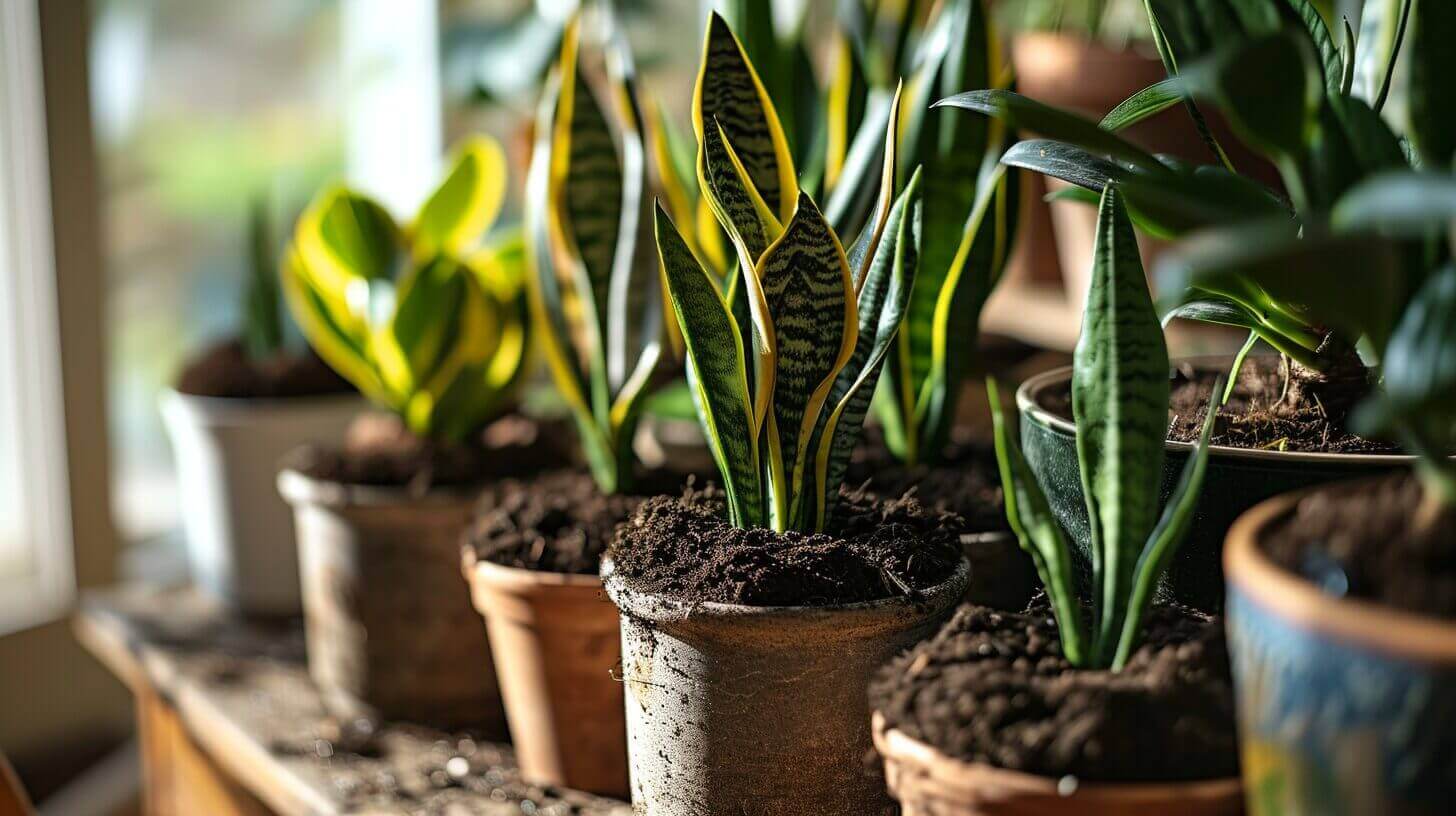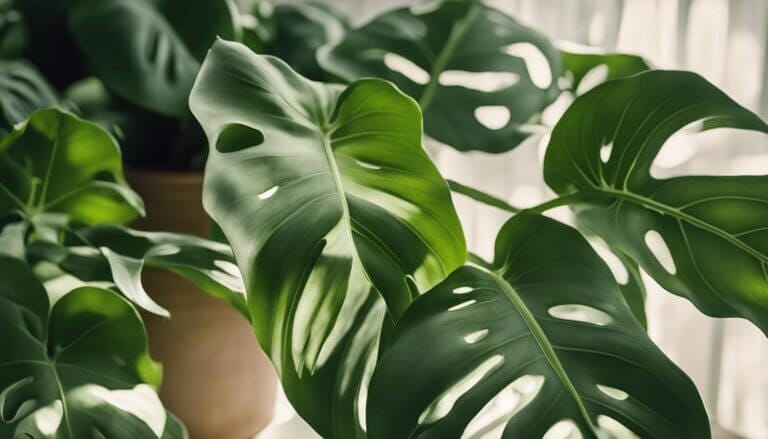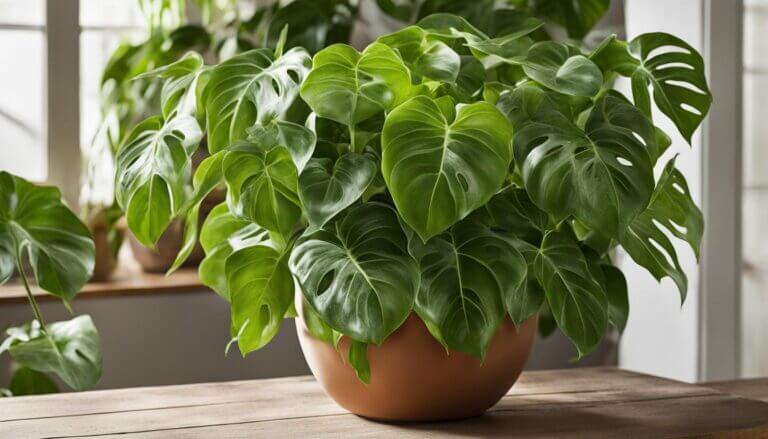How To Choose The Best Snake Plant Soil Mix? Picking the Best Soil for Snake Plant
As we embark on our mission to find the dopest potting mix for Sansevieria growth, we’re gonna dive deep into what to look for when it comes to soil for these well-liked indoor houseplants.
Once you grasp the sheer awesomeness of proper drainage and dabble in different kinds of potting mix, you’ll be armed and dangerous, ready to whip up the ultimate soil concoction for your snake plants.
Prepare to unlock the mysteries behind Sansevieria that’ll have ’em flourishing and popping like nobody’s business with our genius tips.
Key Takeaways
- Snake plants thrive in well-draining soil with a mix of peat moss, perlite or sand, and a small amount of loam or garden soil.
- When choosing soil for snake plants, consider factors such as drainage capabilities, moisture retention, nutrient content, and soil pH.
- Proper drainage is crucial for preventing waterlogging and maintaining ideal moisture levels for snake plants.
- Different types of potting mixes, such as well-draining mix, cactus/succulent mix, peat moss-based mix, and DIY mix, can be used for snake plants depending on specific needs.
Understanding the Soil Needs of Snake Plants
To ensure optimal growth and health, it is essential to comprehend the specific soil requirements of snake plants. The right soil composition plays a crucial role in providing the necessary nutrients and support for these houseplants. Snake plants thrive in well-draining soil that mimics their natural habitat. A good potting mix for snake plants should consist of a combination of organic matter and inorganic materials.
The ideal soil composition for snake plants is a mixture of peat moss, perlite or sand, and a small amount of loam or garden soil. Peat moss helps retain moisture while also promoting good drainage, preventing the soil from becoming too compacted. Perlite or sand aids in improving the soil’s drainage capabilities, preventing waterlogging and root rot. A small amount of loam or garden soil can provide additional nutrients and stability to the potting mix.
Maintaining proper water retention is crucial for snake plants. Overwatering can lead to root rot and other fungal diseases. The well-draining soil composition allows excess water to flow freely, preventing water from pooling around the roots. This helps to maintain the optimal moisture level for the snake plant without causing waterlogged conditions.
Understanding the soil requirements of snake plants is vital for their overall health and growth. By providing the right soil composition and ensuring proper water retention, you can create an ideal environment for your snake plant to thrive.
Factors to Consider When Choosing Best Soil for Snake Plant
When selecting soil for Sansevieria, it is important to consider factors such as drainage capabilities, moisture retention, and nutrient content in order to provide an optimal growing medium for these plants. The soil composition plays a crucial role in the overall health and growth of snake plants.
Here are four important factors to consider when choosing soil for Sansevieria:
Drainage capabilities: Snake plants require well-draining soil to prevent waterlogging, which can lead to root rot. Look for a soil mix that contains ingredients like perlite or sand to improve drainage.
Moisture retention: While good drainage is important, it’s equally crucial to choose a soil mix that can retain some moisture. Sansevieria prefers slightly dry soil and may suffer if the soil dries out completely. Look for a mix that has good moisture retention properties, such as coco coir or peat moss.
Nutrient content: Sansevieria is a low-maintenance plant that doesn’t require high levels of nutrients. However, it’s still essential to choose a soil mix that provides some nutrients to support healthy growth. Look for a mix that is enriched with organic matter or slow-release fertilizers.
Soil pH: Snake plants prefer slightly acidic to neutral soil pH. Aim for a pH range of 6.0 to 7.0 when selecting soil for Sansevieria.
Considering these factors will help ensure that the soil provides the right balance of drainage, moisture retention, and nutrients for your Sansevieria plants.
Now let’s explore the role of drainage in snake plant soil.
The Role of Drainage in Snake Plant Soil Mix
Proper drainage is crucial in snake plant soil as it prevents waterlogging and ensures healthy root development. When it comes to watering snake plants, finding the right balance is essential. Overwatering can lead to root rot and other issues, while underwatering can cause the plant to dry out and suffer. To help maintain the ideal moisture levels, it is important to use well-draining soil that allows excess water to flow out of the pot.
Here is a table that compares different types of potting mixes for snake plants:
| Potting Mix | Description |
|---|---|
| Succulent mix | A mix specifically formulated for succulent plants, which typically contains a combination of sand, perlite, and peat moss. Provides excellent drainage. |
| Cactus mix | Similar to succulent mix, but may contain a higher proportion of sand for even better drainage. Suitable for snake plants that prefer drier conditions. |
| Regular potting mix | A general-purpose mix that works well for snake plants when combined with perlite or sand to improve drainage. |
| DIY mix | A mix created by combining equal parts of potting soil, perlite, and coarse sand. Allows for optimal drainage and aeration. |
Exploring Different Types of Potting Mix for Sansevieria
One of the key factors in ensuring healthy growth for Sansevieria is exploring at least three different types of potting mix options. Choosing the right soil for your snake plant is crucial for its overall health and vitality. The potting mix plays a significant role in providing the necessary nutrients, moisture retention, and drainage for the plant’s roots.
Here are four types of potting mix options to consider:
Well-draining mix: Sansevieria prefers a well-draining soil mixture that allows excess water to flow out easily. A mix of equal parts potting soil, perlite, and coarse sand creates an ideal environment for the roots.
Cactus/succulent mix: This specialized mix is designed to provide excellent drainage while retaining enough moisture for the plant’s needs. It typically consists of a blend of potting soil, perlite, and sand.
Peat moss-based mix: Peat moss retains moisture and provides aeration to the roots. Combining peat moss with perlite and potting soil creates a light and airy mix that helps prevent waterlogging.
DIY mix: For those who prefer a customized option, creating your own potting mix can be a great choice. A mix of potting soil, perlite, and vermiculite allows you to tailor the blend to suit your snake plant’s specific needs.
Tips for Creating the Perfect Soil Mix for Healthy Snake Plant Growth
Three essential tips and an effective soil mix are key to promoting healthy growth in snake plants.
Snake plants, also known as Sansevieria, are popular houseplants due to their low-maintenance nature and ability to thrive in various conditions. However, to ensure optimal growth and overall health, it is important to provide them with the right soil mix.
Firstly, creating optimal conditions for snake plants involves using a well-draining soil mix. This is because snake plants are prone to root rot if their roots sit in waterlogged soil for prolonged periods. A common mistake is using regular potting soil, which can retain too much moisture. Instead, opt for a well-draining mix that contains ingredients such as perlite or vermiculite to improve drainage.
Secondly, snake plants prefer a slightly acidic to neutral pH level. To achieve this, it is recommended to use a soil mix that has a pH range between 6.0 and 7.0. This will help create an environment that allows the roots to absorb nutrients more efficiently.
Lastly, snake plants are native to arid regions and have adapted to survive in sandy soils. Therefore, incorporating a sandy component into the soil mix can mimic their natural habitat and promote healthy root development.
FAQs – Best Snake Plant Soil Mix
What is the Relationship Between Soil Type and Watering Needs for Snake Plants?
The relationship between soil type and watering needs for snake plants is crucial to their overall health. Understanding how to water snake plants correctly is essential in preventing root rot or dehydration. Well-draining soil, such as a mixture of potting soil and perlite, allows excess water to escape, preventing waterlogged roots. By maintaining moist soil and avoiding overwatering, snake plants thrive and remain healthy.
When Should I Repot My Snake Plant and What Soil Should I Use?
Effective sansevieria transplantation involves repotting your snake plant when it becomes rootbound or shows signs of distress. The ideal time for repotting is spring or early summer, as it allows the plant to adjust to new surroundings. Choose a well-draining soil mix, ideally a blend of peat moss, perlite, and loam. This ensures good air circulation around the roots and prevents waterlogged conditions, promoting a healthy growth for your snake plant.
How Do I Know if My Snake Plant Needs to Be Repotted?
To determine if your snake plant needs repotting, look for signs of overwatering, such as yellowing leaves or a foul odor. When choosing a new pot, opt for one that is 1-2 inches larger in diameter than the current pot.
What kind of soil is best for snake plants?
The best soil for snake plants is well-draining soil that allows water to flow through easily. It is recommended to use a succulent or cactus soil mix, or a mixture of regular indoor potting soil and perlite or sand.
Can snake plants grow in regular potting soil?
Snake plants can grow in regular potting soil, but it is important to mix it with materials like perlite or sand to improve the drainage. Regular potting soil alone can compact and retain too much moisture, which can lead to root rot.
Is it important to provide adequate drainage for snake plants?
Yes, providing adequate drainage is crucial for the health of snake plants. They are susceptible to root rot if they sit in soggy soil for extended periods. Make sure the pot has drainage holes and avoid overwatering.
Can I use succulent soil for my snake plant?
Yes, you can use succulent soil for your snake plant. Succulent soil is specially formulated to provide the ideal conditions for succulent plants like snake plants, with a well-draining mix that prevents root rot.
How can I keep my snake plant healthy?
To keep your snake plant healthy, provide it with indirect light, avoid overwatering, and use a well-draining soil mix. Additionally, avoid placing it in areas with extreme temperature fluctuations and gently wipe the leaves to remove dust occasionally.
How should I choose the best soil mix for my snake plant?
When choosing a soil mix for your snake plant, look for one that is specifically labeled for succulents or cacti. These mixes are designed to provide the perfect balance of drainage and moisture retention for plants like snake plants.
Can I use regular potting soil for snake plants?
While regular potting soil can be used for snake plants, it is best to mix it with perlite or sand to improve drainage. Snake plants prefer soil that drains well to prevent root rot and other issues.
Should I use a cactus potting mix for snake plants?
Yes, a cactus potting mix can be a good choice for snake plants. These mixes are designed to provide excellent drainage, which is important for the health of the snake plant’s roots.
What Type of Soil is Best for Maintaining Healthy Snake Plant Leaves?
Pruning Snake Plants enhances the health of their leaves by removing any damaged or dead parts and promoting new growth. When it comes to the best soil for maintaining healthy Snake Plant leaves, a well-draining potting mix is essential. A mixture that consists of peat moss, perlite, and sand ensures proper moisture levels, preventing root rot and allowing adequate air circulation. This type of soil provides optimal conditions for a thriving Snake Plant, resulting in vibrant and lush foliage.
Can I make my own soil mix for snake plants?
Yes, you can make your own soil mix for snake plants. A popular DIY mix includes a combination of organic potting soil, perlite or sand, and a small amount of peat moss or coconut coir for moisture retention.
What are the ideal soil conditions for snake plants?
Snake plants prefer well-drained soil that mimics their natural habitat in arid regions. The soil should be loose, airy, and not too compacted to allow for good root development and prevent waterlogging.
Can the soil mix affect the health of my snake plant?
Absolutely! The type of soil mix you choose can have a direct impact on the health of your snake plant. Using a well-draining soil mix that mimics the plant’s natural environment will help prevent issues like root rot and promote overall plant health.







